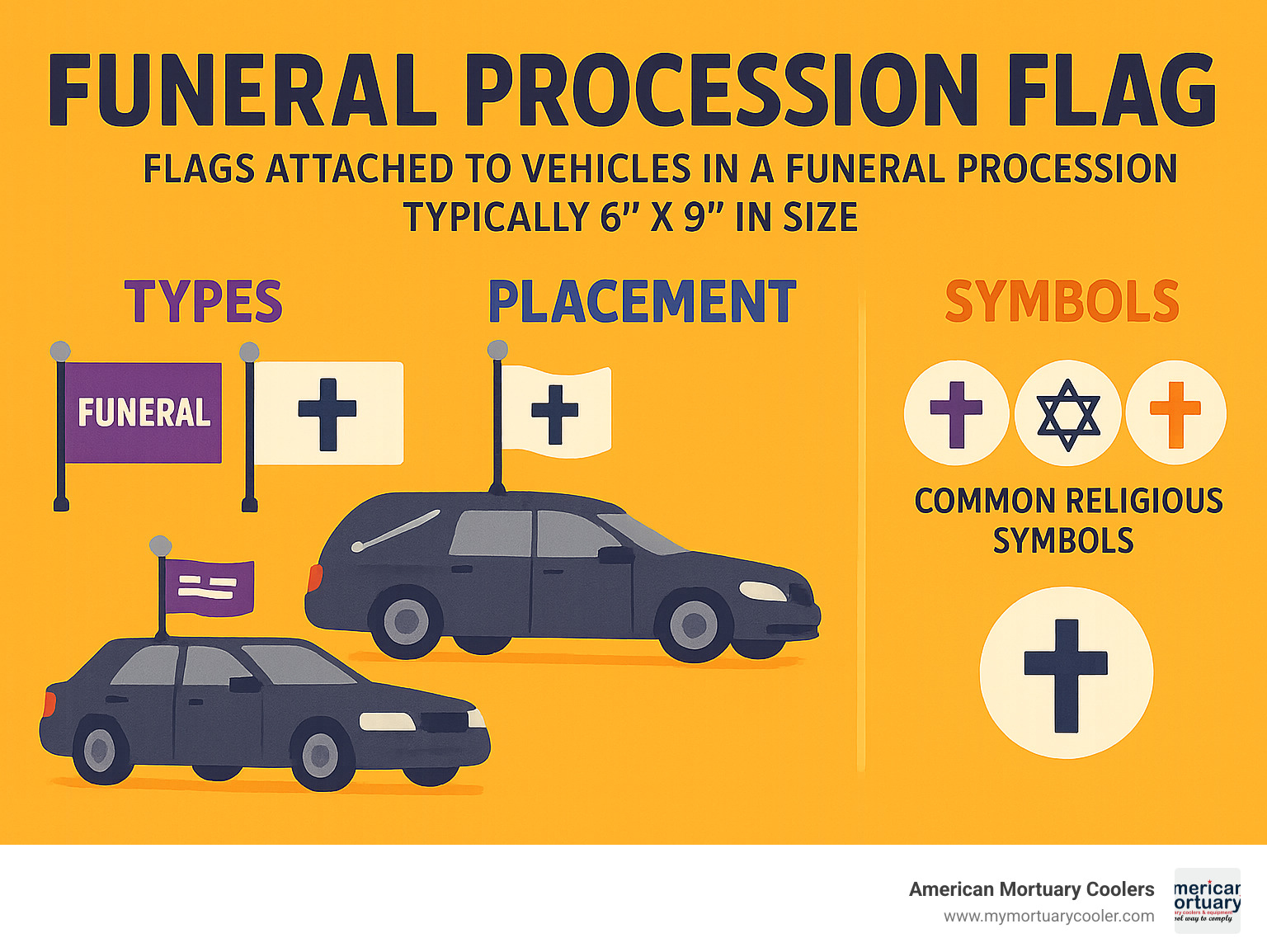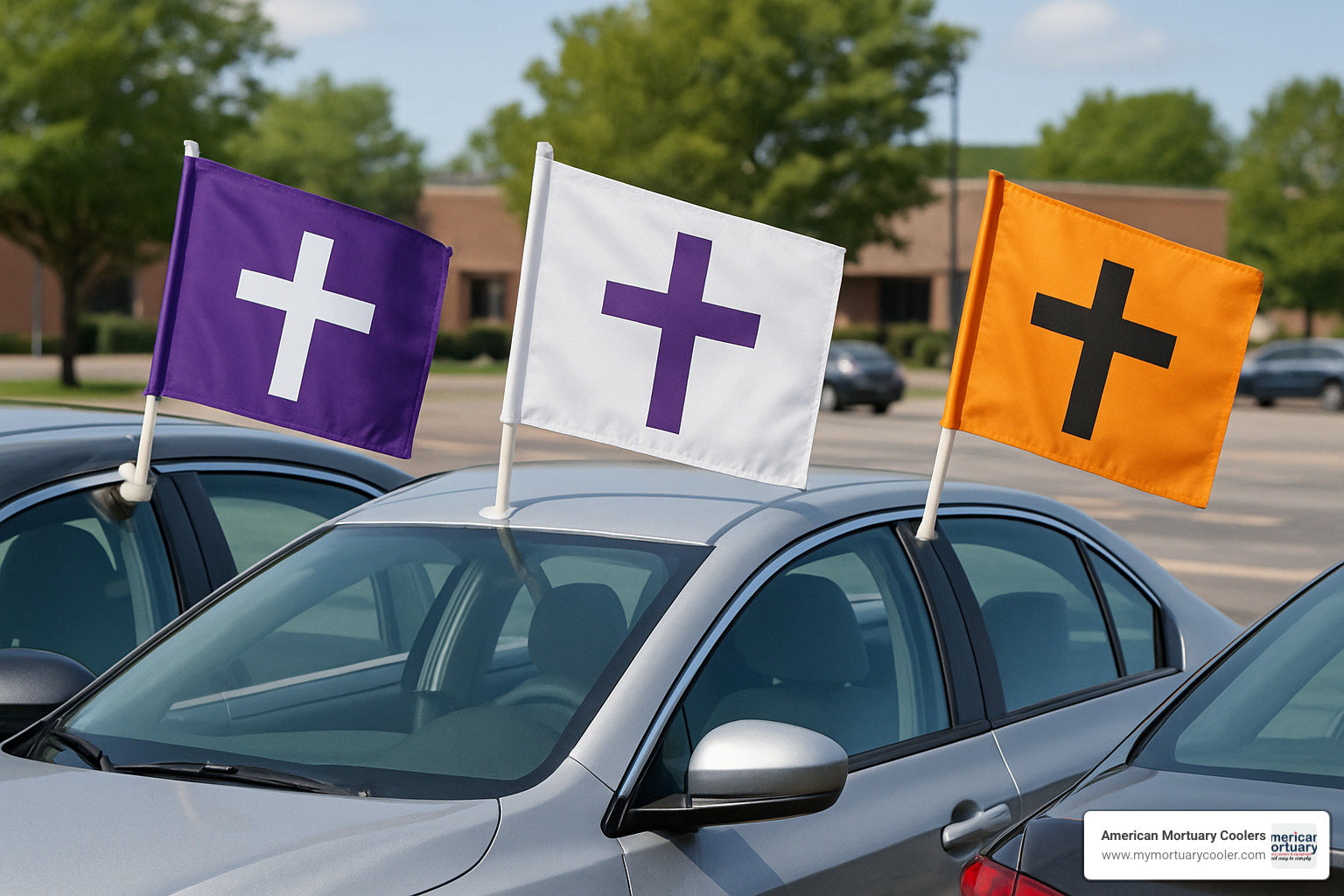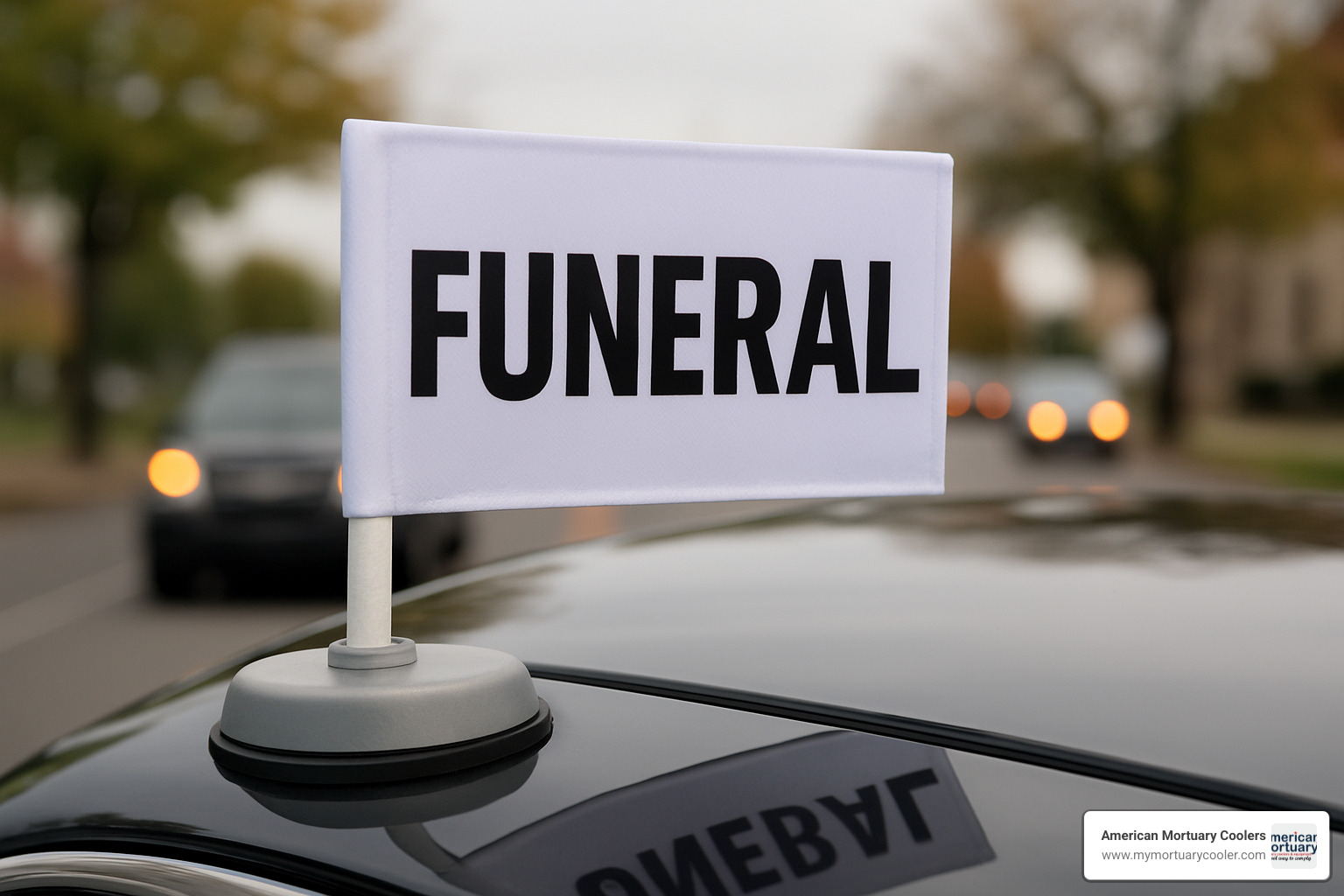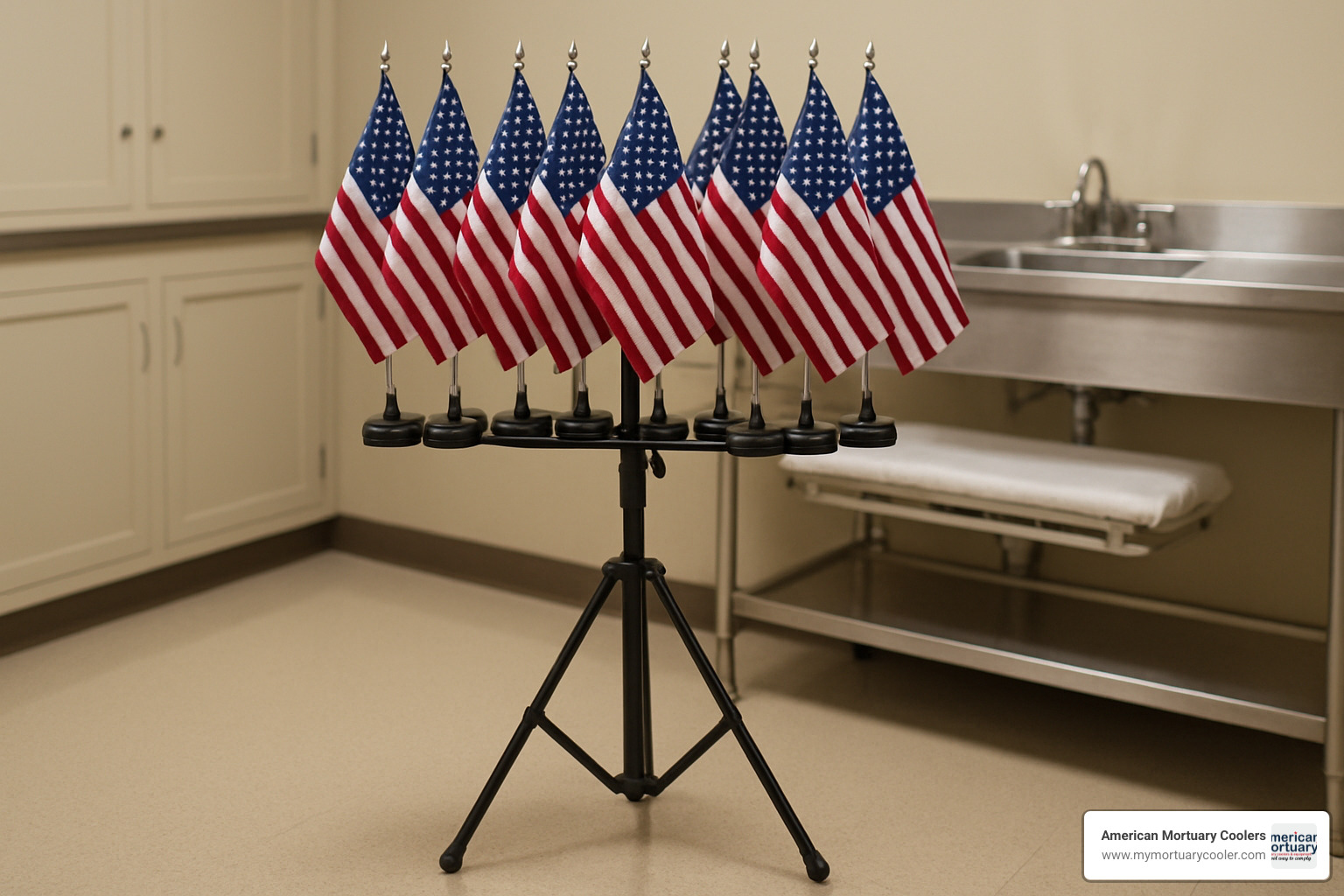The Essential Role of Funeral Procession Flags
Funeral procession flags are specialized banners attached to vehicles participating in a funeral cortege, typically measuring 6" x 9" and mounted on an 11" staff. They serve three critical purposes: identifying vehicles in the procession, enhancing road safety, and honoring the deceased.
| Quick Facts About Funeral Procession Flags |
|---|
| Standard Size: 6" x 9" banner on 11" staff |
| Common Materials: Weather-resistant nylon or polyester |
| Typical Colors: Purple, white, orange with religious symbols |
| Mounting Options: Magnetic base, window clip, or staff mount |
| Average Cost: $11-$23 per flag (often sold by the dozen) |
| Primary Purpose: Vehicle identification, safety, and ceremonial respect |
Funeral processions hold deep symbolic meaning, creating what one manufacturer describes as "a chain of connection, a visible sign of the invisible bond of grief." These flags not only mark vehicles as part of a solemn procession but also signal to other motorists to yield with respect.
Modern funeral procession flags typically feature magnetic bases designed to protect vehicle finishes while ensuring secure attachment at highway speeds. Available in various colors and with different religious symbols (crosses, Stars of David) or text, these flags help maintain the dignity and safety of the funeral journey.
While traditional in nature, these ceremonial markers have evolved to meet contemporary needs. Today's flags offer weather-resistant nylon construction, quick-attach magnetic bases, and customization options that respect various faith traditions while fulfilling their practical purpose.
I'm Mortuary Cooler, and throughout my career supplying equipment to funeral homes nationwide, I've helped countless directors select the appropriate funeral procession flags that balance tradition with practicality for their specific ceremonial needs. My experience has shown that these small but significant items play a crucial role in maintaining the dignity and order of funeral processions.

Learn more about funeral procession flags:
From Tradition to Today: The Story Behind Funeral Procession Flags
The tradition of funeral procession flags has roots that run deep in military history, evolving over centuries into the respectful practice we know today. Back in the late 1700s during the Napoleonic Wars, battlefield flags served a practical purpose – they were draped over fallen soldiers to identify them amid the chaos of war. This simple act of recognition laid the groundwork for how we honor our departed loved ones with flags today.
American funeral traditions took a significant turn during the Civil War, a time when our nation faced unprecedented loss. Military funeral processions began using flags not just as symbols of patriotism, but as practical markers for vehicles carrying the fallen. What began as a military custom gradually found its way into civilian life, becoming a standard element in funeral processions across America's communities.

The colors chosen for funeral procession flags speak a language of their own. Purple, so often seen in funeral settings, carries the weight of dignity and respect in Western mourning traditions. White stands as a symbol of purity and peace for the departed soul. Black, in its somber tone, represents the grief felt by those left behind. The bright orange flags, often seen on lead vehicles, serve a more practical purpose – ensuring visibility and safety as the procession makes its solemn journey.
"Old Glory" – our American flag – holds a special place in military and first responder funerals. This affectionate nickname reportedly came from a 19th-century sea captain who cherished his personal flag, though it later acceptd our national symbol as a whole. When honoring veterans or service members, funeral directors must follow specific protocols outlined in the U.S. Flag Code, ensuring proper respect is maintained throughout the ceremony.
Mourning customs involving flags have naturally evolved with time. In earlier days, flags primarily adorned the hearse or lead vehicle. Modern processions, however, often feature flags on all participating vehicles, creating a visual unity that improves both safety and the sense of shared purpose. This shift reflects both practical concerns in today's busy traffic environments and our enduring need for meaningful symbols during times of loss.
Today's funeral procession flags beautifully blend time-honored tradition with modern practicality. While they carry the same symbolic weight as their historical predecessors, contemporary flags benefit from weather-resistant materials and vehicle-friendly mounting systems that make them both durable and easy to use. These thoughtful improvements allow funeral directors to maintain dignity and tradition while addressing the practical needs of modern processions.
The evolution of these flags reminds us that while the ways we express grief may adapt over time, the human need to honor our departed with dignity and respect remains constant.
How to Choose Funeral Procession Flags for Your Service
Choosing the right funeral procession flags is more than a practical decision—it's part of how we honor our loved ones on their final journey. I've helped countless funeral directors select flags that perfectly balance practicality with meaningful symbolism, and I'm happy to share what I've learned with you.
When you're looking for funeral procession flags, you'll typically find two main styles: simple banners and staff-mounted flags. The banner-only options are more budget-friendly at around $115 per dozen, while complete sets with magnetic staffs range from $175-$230 per dozen. While the complete sets cost more, many funeral directors tell me they appreciate the convenience and professional appearance they provide.

The colors and symbols you choose can speak volumes about the service you're creating. Purple flags with white crosses remain the traditional choice for Christian services, though white flags with purple crosses offer a beautiful alternative. For processions that need extra visibility (particularly lead vehicles), many directors opt for orange flags with black crosses. If you're planning a non-denominational service, flags with "FUNERAL" text in either purple or white backgrounds provide a respectful option without religious symbolism.
How these flags attach to vehicles matters too. Magnetic mounts have become the go-to choice because they secure firmly to metal surfaces without damaging paint finishes. For vehicles where magnets aren't suitable, window clips offer a practical alternative. Some directors, especially for hearses and lead cars, still prefer traditional staff mounts for their classic appearance.
The material of your flags affects both their appearance and longevity. Here's what I've observed working with funeral homes across the country:
| Material | Durability | Weather Resistance | Cost | Best For |
|---|---|---|---|---|
| Nylon | High | Excellent | Medium | Standard processions in all weather |
| Polyester | Very High | Good | Medium-High | Frequent use by funeral homes |
| Cotton | Medium | Poor | Low | Indoor ceremonies or fair weather only |
If you're conducting services regularly, investing in quality flags with superior weather resistance makes good business sense. Funeral homes in areas with unpredictable weather have shared with me that premium weather-guard flags actually save money in the long run by maintaining their dignified appearance through multiple services.
Standard Dimensions & Materials
When it comes to sizing, funeral procession flags follow industry standards that balance visibility with practicality. The typical 6" x 9" banners are perfect for most vehicles in the procession, while larger 9.5" x 17" banners create a more commanding presence on lead cars and hearses. The standard 11" staff height has proven ideal for visibility without creating driving hazards.
These dimensions weren't chosen arbitrarily—they represent years of refinement to ensure flags are noticeable to other motorists without creating excessive wind resistance or becoming unwieldy during the procession.
For materials, nylon with weather-guard treatment has become the industry standard for good reason. These flags stand up beautifully to rain, sun, and wind, typically lasting 2-3 years with proper care. For indoor portions of services or perfect weather conditions, some directors prefer cotton ceremonial flags for their traditional look and feel. When exceptional durability is needed, especially for flags representing military honors, woven polyester offers superior longevity, though at a higher price.
In my years supplying funeral homes across the Southeast and Southwest, I've noticed directors in high-sun regions particularly appreciate UV-resistant materials that prevent that faded, worn look that can detract from the dignity of the service.
Funeral Procession Flags for Different Faiths & Honors
One of the most meaningful aspects of funeral procession flags is how they can reflect the faith traditions and life service of the deceased. This thoughtful customization helps create a more personal and respectful final journey.
For Christian services, cross-adorned flags in purple with white crosses or white with purple crosses provide a visual affirmation of faith. Jewish funeral processions often feature flags with the Star of David, available in both purple and orange backgrounds. For Islamic services, crescent-adorned flags can be ordered, though they typically require more lead time as they're less commonly stocked by suppliers.
When planning services that are secular or include participants from various faith backgrounds, flags with "FUNERAL" text instead of religious symbols offer an inclusive alternative that maintains the procession's dignity.
For those who served our communities and country, specialized flags carry profound meaning. U.S. flags for veteran processions follow specific protocols from the U.S. Flag Code, honoring their service with appropriate ceremony. For first responders, department-specific flags featuring badges or insignia create a fitting tribute to their public service.
The tradition of flag-covered caskets in military services dates back to the late 1700s, and today's ceremonies include a beautiful flag-folding ritual where each of the 13 folds carries special symbolism. Similarly, police and emergency responder funerals blend traditional elements with department-specific honors, creating a ceremony that acknowledges both personal sacrifice and community service.
By selecting flags that truly reflect the deceased's faith and life contributions, you help create a procession that serves as a meaningful tribute during this final journey.
Displaying Funeral Procession Flags Safely on Vehicles
When it comes to funeral procession flags, proper installation isn't just about appearances—it's essential for both safety and maintaining the dignity of the funeral journey. The way you mount these flags affects everything from vehicle protection to how securely they'll stay in place during the procession.
Magnetic bases have become the go-to choice for most modern funeral processions, and for good reason. These thoughtfully designed bases feature plastic-covered contact points that prevent those annoying scratches on your vehicle's finish, while still providing a strong magnetic hold that keeps flags secure even at highway speeds. They work well with both metal surfaces and vinyl-covered car tops, giving you flexibility for different vehicles in the procession.
One quick word of caution though—if you're dealing with heavily padded vinyl tops, magnetic bases might not give you the secure connection you need. In these cases, window clip mounts are your friend, providing a reliable alternative that won't let you down mid-journey.

The order of vehicles in a procession follows meaningful traditions. The lead vehicle—typically the hearse—should display flags prominently, often using larger 9.5" x 17" banners that maximize visibility and signal the procession's beginning. Family vehicles follow next, then friends and other attendees. Some families choose different flag colors or designs to distinguish between immediate family and other participants, creating a visual hierarchy that helps everyone understand the relationships to the deceased.
Beyond the flags themselves, several visibility aids help create a cohesive and safe procession:
Headlight cards slip over headlights to clearly identify procession vehicles, while windshield stickers provide temporary marking for participants. For lead vehicles, magnetic LED lightbars (typically priced around $375) significantly improve visibility, especially in challenging weather or lighting conditions. And don't forget about funeral parking cones, which help organize vehicles before and after the procession, creating order during an emotionally challenging time.
It's worth noting that state laws regarding funeral processions vary quite a bit across the country. In some states, processions are granted the right-of-way at intersections once the lead vehicle has legally entered, while others require each vehicle to obey traffic signals independently. We've seen how this patchwork of regulations can create confusion, which is why funeral directors should always familiarize themselves with local rules to ensure everything goes smoothly.
Speaking of smooth journeys, procession speed matters tremendously. The lead vehicle sets the pace, typically maintaining a steady 25-35 mph on main roads. This thoughtful speed allows the procession to stay together while remaining safe for all participants and other motorists who may be sharing the road.
In our years of working with funeral homes from coast to coast—from busy New York to laid-back Los Angeles—we've observed that clear visibility markings and proper flag placement significantly reduce the risk of procession disruption. When done right, these small details ensure a dignified journey to the final resting place, which is exactly what families deserve during such a difficult time.
For more comprehensive information, check out Everything You Need to Know About Funeral Flags for Cars, which covers additional details that might be helpful as you plan.
Proper Etiquette for Funeral Procession Flags on Vehicles
There's a certain respect and dignity that comes with properly displaying funeral procession flags and following procession etiquette. These traditions not only honor the deceased but help ensure everyone's safety during what can be an emotionally challenging drive.
For drivers joining a funeral procession, several simple but important protocols should become second nature. Keep your headlights on throughout the entire procession, regardless of whether you're driving in bright sunshine or overcast conditions. Activate your hazard lights to increase your visibility to other motorists who might not immediately recognize the nature of the procession.
Stay relatively close to the vehicle ahead—typically about 1-2 car lengths—which helps prevent other traffic from inadvertently cutting into the procession and disrupting the solemn journey. Always follow the lead vehicle's pace without rushing ahead or falling behind, which helps maintain the procession's integrity. And of course, keep an eye on your flags to ensure they remain properly mounted throughout the journey.
Where you place your funeral procession flags depends on the type of vehicle you're driving:
Hearses and lead cars typically display larger flags (9.5" x 17") on both front corners, creating a dignified frame for the vehicle guiding the procession. Family vehicles usually display standard flags (6" x 9") on the driver's side or sometimes on both front corners, identifying them as immediate family. Other procession participants generally display standard flags on the driver's side, creating a unified visual appearance.
Right-of-way rules can be confusing since they vary by state, but generally, other motorists are expected to yield to a funeral procession out of respect. That said, procession participants should remain alert and vigilant, as not all drivers recognize or respect these traditions. The flags serve as important visual signals that help alert other motorists to the procession's purpose and solemn nature.
Maintaining proper spacing between vehicles is crucial for keeping the procession intact. That consistent 1-2 car length spacing prevents other traffic from breaking the line while still maintaining safe following distances. If you do get separated from the procession by traffic lights or other circumstances, calmly catch up when it's safe to do so without violating traffic laws or putting yourself at risk.
For larger processions, particularly those honoring veterans, police officers, or firefighters, you'll often see additional protocols that reflect their service. These might include a color guard leading the procession, specific flag arrangements on the hearse, or department vehicles with specialized flag displays that honor the deceased's service.
Following these etiquette guidelines ensures that the procession fulfills its meaningful purpose—honoring the deceased with dignity—while maintaining safety for everyone involved in this important final journey.
Buying, Caring & FAQs About Funeral Procession Flags
Shopping for funeral procession flags shouldn't feel overwhelming, whether you're a funeral director stocking up or a family arranging a single service. Let me walk you through everything you need to know about purchasing, maintaining, and getting the most from these important ceremonial items.
Most funeral supply companies sell funeral procession flags by the dozen, with prices typically ranging from $11.40 to $230.00 depending on quality and features. While buying in bulk makes perfect sense for funeral homes conducting multiple services throughout the year, it might seem excessive for individual family needs. If you're planning a single funeral, consider asking your funeral director if they can provide flags as part of their service package – most maintain an inventory precisely for this purpose.

You'll find funeral procession flags available from specialty funeral supply companies, general flag manufacturers with funeral divisions, and funeral equipment suppliers like American Mortuary Coolers. For funeral homes purchasing in volume, many suppliers offer attractive tiered pricing for orders of 3 or 5 dozen flags, making it economical to keep different styles on hand for various service needs.
Looking for something personalized? Custom funeral procession flags featuring your funeral home's logo or specific designs are available, though they typically require minimum orders (usually 3-5 dozen) and come with a production lead time of 2-3 weeks. While the additional cost might not make sense for one-time use, custom flags can add a professional touch that families appreciate.
For funeral homes maintaining an inventory of flags, proper storage makes all the difference in extending their lifespan. Purpose-designed flag storage carriers hold up to 24 flags in a free-standing tripod design, keeping them organized, protected, and ready whenever needed. This simple investment prevents damage and ensures your flags always look dignified and professional.
Caring for Your Funeral Procession Flags
With proper care, your funeral procession flags can remain presentable and functional through dozens of services. The good news is that quality flags are built to last, and simple maintenance goes a long way.
When it comes to cleaning nylon funeral procession flags, gentle is the way to go. Hand-wash them with mild soap and cool water, taking care to rinse thoroughly so no soap residue remains. Allow them to air dry flat or hanging in a well-ventilated area – never use a dryer, as the heat can damage the nylon material and compromise its integrity.
Those magnetic bases need attention too. I recommend checking the magnetic strength periodically and cleaning the surface to remove any accumulated road debris. Store them in a dry location to prevent rust or corrosion, and if you notice the magnetic strength diminishing, it's time for replacement – better safe than sorry when it comes to flags potentially detaching during a procession.
Between services, proper storage makes all the difference. Rather than folding your funeral procession flags (which can create permanent creases), gently roll the banners instead. Keep them in a cool, dry place away from direct sunlight, ideally in a dedicated flag storage carrier. If you're storing flags with magnetic bases, keep the magnets separated to prevent them from attracting each other and potentially damaging the fabric.
UV exposure is particularly tough on flags. Those used regularly in sunny locations like our service areas in Los Angeles or throughout the Southwest Region may need replacement more frequently than those used primarily in overcast conditions. With proper care, however, you can expect high-quality nylon banners to last 2-3 years of regular use, magnetic bases 3-5 years, and staff assemblies 5+ years with proper maintenance.
Frequently Asked Questions about Funeral Procession Flags
Q: Where can I purchase funeral procession flags for a single funeral?
A: While most suppliers sell flags by the dozen, some funeral supply companies offer individual flags for one-time use. Your best bet is asking your funeral director if they can include procession flags in their services, as most maintain an inventory for this purpose. At American Mortuary Coolers, we've seen many funeral homes include these as part of their comprehensive service packages.
Q: Are there legal requirements for using funeral procession flags?
A: The flags themselves aren't typically regulated, but how processions operate on roadways is subject to local traffic laws. Requirements vary by state and locality, including right-of-way rules and escort requirements. Your funeral director should be familiar with local regulations and can guide you appropriately.
Q: Can I get custom funeral procession flags with our family name or a special message?
A: Yes, custom funeral procession flags are available, but they typically require minimum order quantities (often 3-5 dozen) and have a production lead time of 2-3 weeks. For individual services, standard flags with appropriate religious or non-denominational symbols are usually more practical and readily available.
Q: How long does it take to receive an order of funeral procession flags?
A: Standard flags typically ship within 2-3 days from major suppliers. Custom flags need longer lead times, usually 2-3 weeks for production plus shipping. Many suppliers offer expedited shipping for urgent needs.
Q: Are magnetic funeral flags safe for all vehicle finishes?
A: Funeral procession flags with magnetic bases are designed to be safe for most vehicle finishes. They feature plastic-covered contact points to prevent scratching on metal and vinyl-covered tops. However, they're not recommended for heavily padded vinyl tops, as the magnetic connection may not be secure enough. Always ensure the vehicle surface is clean before applying magnetic flags.
Q: How do I know which religious symbol is appropriate for the funeral procession?
A: The religious symbol should reflect the faith of the deceased. When in doubt, consult with family members or religious leaders. Non-denominational options with "FUNERAL" text work well for secular services or when participants come from various faith backgrounds.
Q: Can funeral procession flags be used in all weather conditions?
A: Weather-resistant nylon flags handle various conditions including rain and moderate wind. However, extreme weather such as heavy storms or high winds may damage flags or make them unsafe. Premium weather-guard flags offer the best durability when the forecast looks challenging.
At American Mortuary Coolers, we understand that every detail matters when honoring a loved one. While our primary focus is on mortuary coolers and related equipment, we recognize the importance of having dependable sources for all funeral service needs, including procession flags that represent your establishment with dignity. For more information about complete mortuary solutions, visit our funeral home supplies page.
Conclusion
There's something deeply meaningful about the way funeral procession flags transform an ordinary line of vehicles into a dignified final journey. These small banners do more than just identify cars in a procession – they tell a story of respect, connection, and honor during one of life's most difficult transitions.
Throughout history, from Civil War processions to modern ceremonies, these flags have evolved while staying true to their purpose. Today's weather-resistant magnetic designs may look different from their historical counterparts, but they carry the same message: this procession deserves recognition and respect.
When choosing funeral procession flags for a service, the details matter. The right religious symbol, a secure mounting system, and quality materials create not just a more professional appearance, but genuine peace of mind. There's enough to worry about during a funeral without wondering if flags will stay attached or withstand a sudden rain shower.
The etiquette surrounding these flags – from proper placement on vehicles to how drivers should behave in the procession – helps maintain the dignity the occasion deserves. By following the guidelines we've shared, you're honoring traditions while adapting them to today's roads and vehicles.
At American Mortuary Coolers, we understand that every element of a funeral service contributes to its meaning. While we primarily focus on creating high-quality mortuary coolers for funeral homes nationwide, we recognize that items like procession flags are essential pieces of the bigger picture. Our dedication to supporting funeral professionals extends beyond our coolers to every aspect of their important work.
Whether you're a funeral director looking to refresh your procession supplies or a family member trying to understand these traditions, I hope this guide has given you valuable insights into funeral procession flags. These small but significant items help transform a simple journey into something more meaningful – a final tribute that honors a life with respect, visibility, and care.
For more information about complete mortuary solutions, including our custom-crafted coolers designed specifically for funeral homes across the country, we invite you to explore our full range of products and services.
















